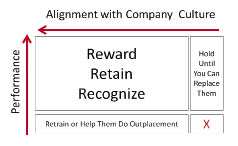You’ve heard of the Academy Awards for movies and the Baldrige Award for quality, but have you heard of the “Employer Choice Award?” If you’ve heard of it, would you deserve it if you were nominated?
Attracting and keeping employees is arguably your most important responsibility as leader of your dealership. In many farming areas, the number of qualified people who want to work in farm equipment is limited. Do you want them to work for you or for your competitor?
We use the chart on the next page in our work with dealers to classify employees that you should keep and those that you should let go. While the chart focuses on employees, this article focuses on you as the employer and presents those things you must consider to help you become the Employer of Choice in your area. And, what do you need to do to be able to classify more of your employees in the upper left quadrant rather than the lower right.
When you get frustrated with an employee’s performance, do you look at what you’re doing? Do you ask yourself if you’ve done enough to help that employee, know what you want for your dealership and how they can be part of your vision? Have you told them what you expect and to set your expectations high, yet achievable? Employees respond to your expectations, how you measure their progress and how you recognize their results.
There are 4 things you must do to produce the behavior and performance from your employees.
1. Motivate around your vision
2. Expect the best
3. Measure — then communicate the measures constantly
4. Recognize — the right way
 Motivate Around Your Vision
Motivate Around Your Vision
As the leader, it’s your responsibility to establish and communicate your vision so it motivates your employees. Communicating it once is not enough. A company vision may be communicated to employees when they’re hired, and it may be posted on the wall of the company where we hope employees will read it often. This doesn’t happen.
As the leader, you must communicate what you want for your business frequently and in various ways. Employees need to know where you’re going and how they’re a part of your journey. When they know what they’re doing contributes to your vision, they are motivated to perform. It’s powerful motivation to know you’re part of a winning team.
Consider carefully what you need from your employees and what it will take to focus their effort and energy on achieving your vision.
Expect the Best
Experience shows that employees respond to their leader’s expectations of them, as long as they’re convinced they’re attainable. This doesn’t mean they meet only an increment of your expectations or only the goals that are easily reachable. It means matching or exceeding the high levels that the best farm equipment dealers achieve on a daily basis. By these standards, you’re asking your employees to stretch themselves beyond what is convenient and easily achievable.
For example, if your service technicians currently bill 60% of their paid hours, then you should expect no less than 85%. Why? Because an 85% bill rate is the benchmark for service departments in this industry. Don’t accept 70% because it’s a convenient or easily achievable target.
Setting expectations (goals) is not the employee’s responsibility. It’s yours as a manager. It’s your job to research industry best practices, set the targets and measure progress.
What would reaching for this best practice mean to your dealership? Table 1 shows the increase in revenues you can expect by setting performance standards to match industry benchmarks.
The impact on bottom-line revenues by raising the service department’s goals by a “convenient” 10-points compared to targeting an industry best 25-point increase is huge. As shown, you can achieve a 42% improvement in billing with no increase in fixed costs or increased outlays.
Measure — Then Communicate
Measuring progress, which is followed by communication, follows setting
 |
|
|
Chart classifies employees that should be kept and those that shouldn’t be.
|
expectations. You need to determine how you will measure employee progress by finding meaningful, yet simple and understandable ways to calculate progress.
A traditional way of communicating is to post a report, using charts, graphs or numbers, which shows actual performance vs. goals.Whatever you do, repeat it over and over. Make the communication part of your company’s culture. The following is a good, practical, real-world example.
Recently, we walked through a dealer’s shop and noticed large white posters in each service bay. The poster indentified the machine being worked on, the date the unit came in for repair and when the dealership had committed to having it fixed and back to the customer. Every day the service manager updated the number of days the unit had been in the shop. Everyone involved — employees, management, customers — got a progress report by walking through the shop.
Recognize — The Right Way
While you can set your vision, communicate it frequently, expect and measure
progress, but you must also remind your employees that you recognize and appreciate their progress. Personal recognition is the most powerful incentive you can give an individual, and is doesn’t have to cost much, if done the right way for each person.
How do you recognize your people? Some dealers do it with money. Some do it by bringing the star achievers to the front of the room to receive a plaque. Others do it by ridiculing employees who didn’t make the grade. Whether these methods are good or bad, you need to determine what fits your organization. You also need to be a good judge of people, character and timing in what you do.
Some people are extroverts and bask in the glow of the recognition spotlight. These people love to be asked to stand up and be recognized in front of their peers and given an award that they can proudly display in their work areas.
Other people would sooner get a warm hug, an arm around the back and very quiet thank you for a job well done. If you can’t tell the difference, you’ll probably end up slighting the one and embarrassing the other. Being a great manager and leader is not about just knowing benchmarks and numbers, but it’s also about reading people. If you’re a natural, in all likelihood, it shows. If not, it’s a skill that can be learned. But it will take work, timing and reinforcement to master.
When judging which employees should be replaced or retrained, and which should be recognized and rewarded, consider your role in their performance.
Are you motivating them with your vision, establishing clear, high, yet realistic expectations, measuring progress and recognizing them appropriately? Or do your people work at your dealership because they can’t afford to leave?
Are you the Employer of Choice or the Employer of Last Resort?







Post a comment
Report Abusive Comment